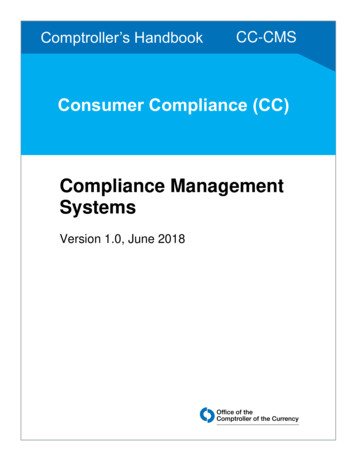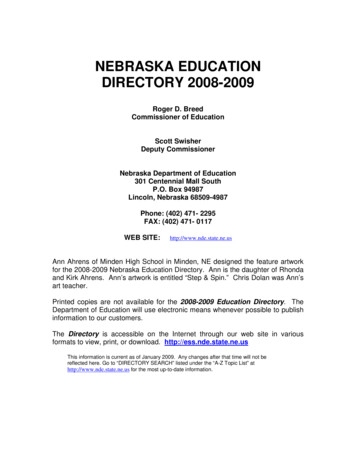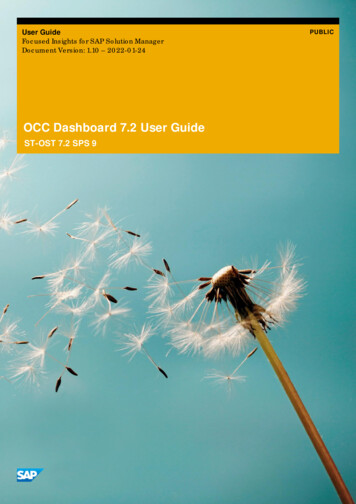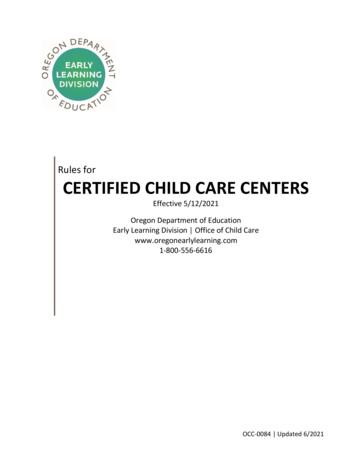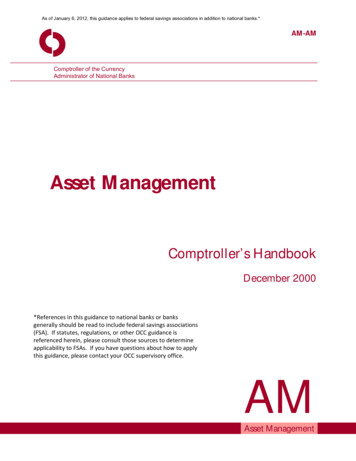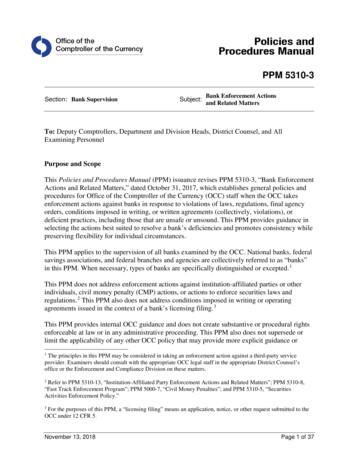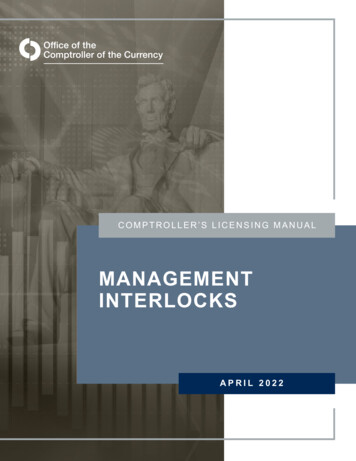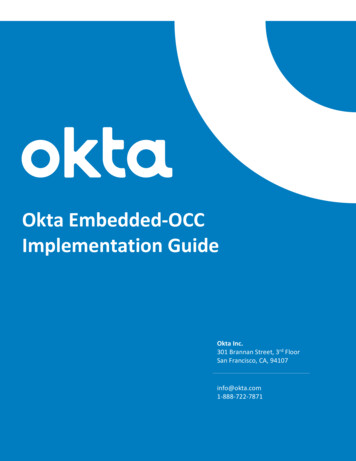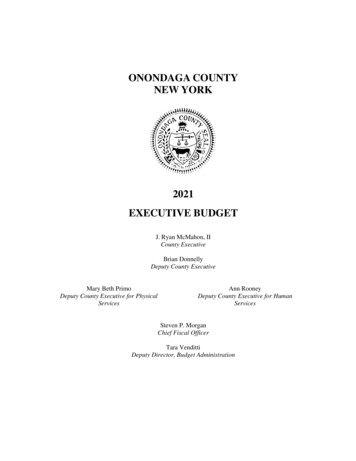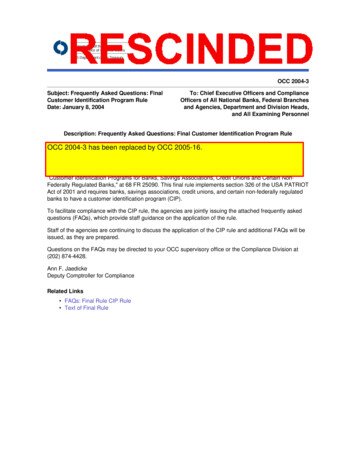
Transcription
Page 1 of 1OCC 2004-3Subject: Frequently Asked Questions: FinalCustomer Identification Program RuleDate: January 8, 2004To: Chief Executive Officers and ComplianceOfficers of All National Banks, Federal Branchesand Agencies, Department and Division Heads,and All Examining PersonnelDescription: Frequently Asked Questions: Final Customer Identification Program RuleTheguidanceto thisbulletin bycontinuesto apply to federal savings associations.OCC2004-3attachedhas beenreplacedOCC 2005-16.On May 9, 2003, the Comptroller of the Currency, Federal Reserve Board, Federal Deposit InsuranceCorporation, Financial Crimes Enforcement Network, Office of Thrift Supervision, National Credit UnionAdministration, and the Treasury Department published a joint final rule, 31 CFR 103.121, titled"Customer Identification Programs for Banks, Savings Associations, Credit Unions and Certain NonFederally Regulated Banks," at 68 FR 25090. This final rule implements section 326 of the USA PATRIOTAct of 2001 and requires banks, savings associations, credit unions, and certain non-federally regulatedbanks to have a customer identification program (CIP).To facilitate compliance with the CIP rule, the agencies are jointly issuing the attached frequently askedquestions (FAQs), which provide staff guidance on the application of the rule.Staff of the agencies are continuing to discuss the application of the CIP rule and additional FAQs will beissued, as they are prepared.Questions on the FAQs may be directed to your OCC supervisory office or the Compliance Division at(202) 874-4428.Ann F. JaedickeDeputy Comptroller for ComplianceRelated Links FAQs: Final Rule CIP Rule Text of Final 04/bulletin-2004-3.html7/30/2012
OCC 2004-3AttachmentFAQs: Final CIP RuleThe staff of the Board of Governors of the Federal Reserve System, Federal Deposit InsuranceCorporation, Financial Crimes Enforcement Network, National Credit Union Administration,Office of the Comptroller of the Currency, Office of Thrift Supervision, and the United StatesDepartment of the Treasury (“Agencies”) are issuing these frequently asked questions (“FAQs”)regarding the application of 31 C.F.R. § 103.121. This joint regulation implements section 3261of the USA PATRIOT Act and requires banks, savings associations, credit unions and certainnon-federally regulated banks (“bank”) to have a Customer Identification Program (“CIP”).While the purpose of the FAQs document is to provide interpretive guidance with respect to theCIP rule, the Agencies recognize that this document does not answer every question that mayarise in connection with the rule. The Agencies encourage banks to use the basic principles setforth in the CIP rule, as articulated in these answers, to address variations on these questions thatmay arise, and expect banks to design their own programs in accordance with the nature of theirbusiness.The Agencies wish to emphasize that a bank’s CIP must include risk-based procedures forverifying the identity of each customer to the extent reasonable and practicable. It is critical thateach bank develop procedures to account for all relevant risks including those presented by thetypes of accounts maintained by the bank, the various methods of opening accounts provided, thetype of identifying information available, and the bank’s size, location, and type of business orcustomer base. Thus, specific minimum requirements in the rule, such as the four basic types ofinformation to be obtained from each customer, should be supplemented by risk-basedverification procedures, where appropriate, to ensure that the bank has a reasonable belief that itknows each customer’s identity.The Agencies note that the CIP, while important, is only one part of a bank’s BSA/AMLcompliance program. Adequate implementation of a CIP, standing alone, will not be sufficientto meet a bank’s other obligations under the BSA, regulations promulgated by its primaryFederal regulator, such as Suspicious Activity Reporting requirements, or regulationspromulgated by the Office of Foreign Assets Control.Finally, these FAQs have been designed to help banks comply with the requirements of the CIPrule. They do not address the applicability of any other Federal or state laws.31 C.F.R. § 103.121(a)(1) -- Definition of “account”1. The CIP rule applies to a “customer,” which is generally “a person that opens a newaccount.” (Emphasis added.) At what point does the CIP rule apply when the account is aloan? When is the account opened?“Customer” does not include a person who does not receive banking services, such as a personwhose loan application is denied. See 68 FR 25090, 25093 (May 9, 2003). Therefore, when the1Section 326 of the Act adds a new subsection (l) to 31 U.S.C. § 5318 of the Bank Secrecy Act (“BSA”).
OCC 2004-3Attachmentaccount is a loan, the account is opened when the bank enters into an enforceable agreement toprovide a loan to the customer.2. Are loan participations purchased from third parties and loans purchased from a cardealer or mortgage broker within the exclusion from the definition of “account” for loansacquired through an acquisition, merger, purchase of assets, or assumption of liabilities?Yes, this exclusion is intended to cover loan participations purchased from third parties and loanspurchased from a car dealer or mortgage broker. If, however, the bank is extending credit to theborrower using a car dealer or mortgage broker as its agent, then it must ensure that the dealer orbroker is performing the bank’s CIP.31 C.F.R. § 103.121(a)(2) -- Definition of “bank”1. Is the CIP rule applicable to a bank’s foreign subsidiaries?No. The CIP rule does not apply to any part of the bank located outside of the United States.Nevertheless, as a matter of safety and soundness, banks are encouraged to implement aneffective CIP throughout their operations, including in their foreign offices, except to the extentthat the requirements of the rule would conflict with local law.31 C.F.R. § 103.121(a)(3) -- Definition of “customer”1. Who is the “customer” when an account is opened by an individual who has power-ofattorney for a competent person who is the named owner of the account?The CIP rule provides that a “customer” generally is “a person that opens a new account.” 31C.F.R. § 103.121(a)(3)(i)(A). When an account is opened by an individual who has power-ofattorney for a competent person, the individual with a power-of-attorney is merely an agentacting on behalf of the person that opens the account. Therefore, the “customer” will be thenamed owner of the account rather than the individual with a power-of-attorney over theaccount. By contrast, an individual with power-of-attorney will be the “customer” if the accountis opened for a person who lacks legal capacity. 31 C.F.R. § 103.121(a)(3)(i)(B)(1).2. Is a person who becomes co-owner of an existing deposit account a “customer” to whomthe CIP rule applies?Yes, a person who becomes the co-owner of an existing deposit account is a “customer” subjectto the CIP rule because that person is establishing a new account relationship with the bank.3. Is a new borrower who is substituted for an existing borrower through an assumption ofa loan a “customer” to whom the CIP rule applies?Yes, a new borrower who is substituted for an existing borrower through an assumption of a loanis a “customer” because the new borrower is establishing a new account relationship with thebank.2
OCC 2004-3Attachment4. The CIP rule requires a bank to verify the identity of each “customer.” Under the CIPrule, a “customer” generally is defined as “a person that opens a new account.” If apension plan administrator chooses to remove a former employee from the plan pursuantto section 657(c) of the Economic Growth and Tax Relief Reconciliation Act of 2001(EGTRRA), it is required by law to transfer these funds to a financial institution. Inaddition, an administrator of a terminated plan may remove former employees that it isunable to locate, by transferring their benefits to a financial institution. Would a planadministrator or the former employee be a bank “customer” where funds are transferredto a bank and an account established in the name of the former employee, in either of thesesituations?In either situation, the administrator has no ownership interest in or other right to the funds, andtherefore, is not the bank’s “customer.” Nor would we view the administrator as acting as thecustomer’s agent when the administrator transfers the funds of former employees in thesesituations. A customer relationship arises and the requirements of the rule are implicated whenthe former employee “opens” an account. While the former employee has a legally enforceableright to the funds that are transferred to the bank, the employee has not exercised that right untilhe or she contacts the bank to assert an ownership interest. Thus, in light of the requirementsimposed on the plan administrator under EGTRRA, as well as the requirements in connectionwith plan terminations, the former employee will not be deemed to have “opened a new account”for purposes of the CIP rule until he or she contacts the bank to assert an ownership interest overthe funds, at which time a bank will be required to implement its CIP with respect to the formeremployee.This interpretation applies only to (1) transfers of funds as required under section 657(c) ofEGTRRA, and (2) transfers to banks by administrators of terminated plans in the name ofparticipants that they have been unable to locate, or who have been notified of termination buthave not responded, and should not be construed to apply to any other transfer of funds that mayconstitute opening an account.5. A bank is an agent for a (bank) credit card issuer. The cards are co-branded, the twobanks share in the revenue from the cards issued. However, the issuer approves the creditcard applications and handles collections. Is a person who obtains a credit card a customerof the agent bank or the card issuer?A person who receives a credit card is receiving an extension of credit from, and therefore isestablishing an account with, the issuing bank. The agent bank is compensated by the issuingbank and not by the customer. For these reasons, the issuing bank is responsible for ensuringthat its CIP applies to the customer. However, the agent bank may perform parts of the CIP onbehalf of the issuing bank. As with any other responsibility performed by an agent, the issuingbank ultimately is responsible for the agent’s compliance with the requirements of the CIP rule.See 68 FR 25090, 25104 (May 9, 2003). Alternatively, the issuing bank may rely upon the agentbank to perform elements of its CIP, provided that the issuing bank is able to satisfy therequirements of the reliance provision, 31 C.F.R. § 103.121(b)(6), including the requirement thatthe person be a customer of both the issuing and agent bank.3
OCC 2004-3Attachment31 C.F.R. § 103.121(a)(3)(ii)(C) – Person with an existing account1. A loan and a time deposit are each an “account” for purposes of the CIP rule. How dothe requirements of the CIP rule apply to a loan that is renewed, or a certificate of depositthat is rolled over?The CIP rule applies to a “customer,” generally, “a person that opens a new account.” 31 C.F.R.§ 103.121(a)(3)(i). (Emphasis added.) “Account” means a formal banking relationshipestablished to provide or engage in services, dealings, or other financial transactions including adeposit account, a transaction or asset account, a credit account, or other extension of credit. 31C.F.R. § 103.121(a)(1)(i). For purposes of the CIP rule, each time a loan is renewed or acertificate of deposit is rolled over, the bank establishes another formal banking relationship anda new account is established. However, the rule provides that the term “customer” does notinclude a person that has an existing account with the bank, provided that the bank has areasonable belief that it knows the true identity of the person. 31 C.F.R. § 103.121(a)(3)(ii)(C).In each of these cases, the customer has an existing account. Therefore, as long as the bank has areasonable belief that it knows the person’s true identity, the bank need not perform its CIP whena loan is renewed or certificate of deposit is rolled over. However, if a new customer is added tothe loan or deposit account, the bank would need to satisfy the CIP rule with respect to that newaccount relationship.2. Does the exclusion from the definition of “customer” in 31 C.F.R. § 103.121(a)(3)(ii)(C)for a person with an existing account extend to a person who has had an account with thebank in the last twelve months but who no longer has an account?No, this provision only excludes from the definition of “customer” a person that at the time anew account is opened currently “has an existing account with the bank,” and only if the bankhas a reasonable belief that it knows the true identity of the person. Therefore, for example,when a person has a deposit account and subsequently obtains a loan, the person has an existingaccount with the bank. Conversely, a person would not be deemed to have an existing account atthe bank if the person had a loan, paid it off, and twelve months later obtains a new loan.3. How can a bank demonstrate that it has “a reasonable belief that it knows the trueidentity of a person with an existing account” with respect to persons that had accountswith the bank as of October 1, 2003?Among the ways a bank can demonstrate that it has “a reasonable belief” is by showing that priorto the issuance of the final CIP rule, it had comparable procedures in place to verify the identityof persons that had accounts with the bank as of October 1, 2003, though the bank may not havegathered the very same information about such persons as required by the final CIP rule.Alternative means include showing that the bank has had an active and longstanding relationshipwith a particular person, evidenced by such things as a history of account statements sent to theperson, information sent to the IRS about the person’s accounts without issue, loans made andrepaid, or other services performed for the person over a period of time. This alternative,however, may not suffice for persons that the bank has deemed to be high risk.4
OCC 2004-3Attachment4. Can a bank exclude from the definition of “customer” a person that has an existingaccount with its affiliate?No, a person that has an existing account with a bank affiliate does not qualify as “a person whohas an existing account with the bank” within the meaning of 31 C.F.R. § 103.121(a)(3)(ii)(C).However, the bank may be able to rely on its affiliate to perform elements of its CIP, as providedin 31 C.F.R. § 103.121(b)(6).31 C.F.R. § 103.121(b)(2)(i) -- Information required1. What address should be obtained for customers who live in rural areas who do not havea residential or business address or the residential or business address of next of kin oranother contact individual? For example, is a rural route number acceptable?Yes, the number on the roadside mailbox on a rural route is acceptable as an address. A ruralroute number, unlike a post office box number, is a description of the approximate area wherethe customer can be located. In the absence of such a number, and in the absence of a residentialor business address for next of kin or another contact individual, a description of the customer’sphysical location will suffice.2. Can a bank open an account for a U.S. person that does not have a taxpayeridentification number?No, the bank cannot unless the customer has applied for a taxpayer identification number, thebank confirms that the application was filed before the customer opened the account, and thebank obtains the taxpayer identification number within a reasonable period of time after theaccount is opened. Note, however, that a bank does not need to obtain a taxpayer identificationnumber when opening a new account for a customer that has an existing account, as long as thebank has a reasonable belief that it knows the true identity of the customer. A bank may alsoopen an account for a person who lacks legal capacity with the identifying information, includingtaxpayer identification number, of an individual who opens an account for that person.31 C.F.R. § 103.121(b)(2)(ii) -- Customer verification1. Must a bank verify the accuracy of all of the identifying information it collects inconnection with 31 C.F.R. § 103.121(b)(2)(i)?The final rule provides that a bank’s CIP must contain procedures for verifying the identity of thecustomer, “using the information obtained in accordance with paragraph (b)(2)(i),” namely theidentifying information obtained by the bank. 31 C.F.R. § 103.121(b)(2)(ii). A bank need notestablish the accuracy of every element of identifying information obtained but must do so forenough information to form a reasonable belief it knows the true identity of the customer. See68 FR 25090, 25099 (May 9, 2003).2. Can a bank use an employee identification card as the sole means to verify a customer’sidentity?5
OCC 2004-3AttachmentA bank using documentary methods to verify a customer’s identity must have procedures that setforth the documents that the bank will use. The CIP rule gives examples of types of documentsthat have long been considered primary sources of identification and reflects the Agencies’expectation that banks will obtain government-issued identification from most customers.However, other forms of identification may be used if they enable the bank to form a reasonablebelief that it knows the true identity of the customer. Nonetheless, given the availability ofcounterfeit and fraudulently obtained documents, a bank is encouraged to obtain more than asingle document to ensure that it has a reasonable belief that it knows the customer’s trueidentity.3. Can a bank use an electronic credential, such as a digital certificate, as a nondocumentary means to verify the identity of a customer that opens an account over theInternet or through some other purely electronic channel?A bank may obtain an electronic credential, such as a digital certificate, as one of the methods ituses to verify a customer’s identity. However, the CIP rule requires the bank to have areasonable belief that it knows the true identity of the customer. Therefore, for example, thebank is responsible for ensuring that the third party uses the same level of authentication as thebank itself would use. See also FFIEC guidance titled “Authentication in an Electronic BankingEnvironment” (July 30, 2001).4. How should a bank verify the identity of a partnership that opens a new account whenthere are no documents or non-documentary methods that will establish the identity of thepartnership?A bank opening an account for such a partnership must undertake additional verification byobtaining information about the identity of any individual with authority or control over thepartnership account, in order to verify the partnership’s identity, as described in 31 C.F.R.§ 103.121(b)(2)(ii)(C).5. How should a bank verify the identity of a sole proprietorship that opens a new account,(such as an account titled in the name of an individual “doing business as” a soleproprietorship) when there are no documents or non-documentary methods that willestablish the identity of the sole proprietorship?In some states, sole proprietorships are required to file “fictitious” or “assumed namecertificates.” Banks may choose to use these certificates as a means to verify the identity of asole proprietorship, if appropriate. However, when there are no documents or non-documentarymethods that will establish the identity of the sole proprietorship, the bank must undertakeadditional verification by obtaining information about the sole proprietor or any other individualwith authority or control over the sole proprietorship account -- such as the name, address, dateof birth, and taxpayer identification number of the sole proprietor, or any other individual withauthority or control over the account -- in order to verify the sole proprietorship’s identity, asdescribed in 31 C.F.R. § 103.121(b)(2)(ii)(C).6
OCC 2004-3Attachment31 C.F.R. § 103.121(b)(3)(i) – Required records1. Would it be acceptable to retain a description of the non-documentary customerverification method used (such as a consumer credit report or an inquiry to a frauddetection system) in a general policy or procedure instead of recording the fact that aparticular method was used on each individual customer's record?Yes, provided that the record cross-references the specific provision(s) of the risk-basedprocedures contained in the bank’s CIP used to verify the customer’s identity.2. Can a bank keep copies of documents provided to verify a customer’s identity, inaddition to the description required under 31 C.F.R. § 103.121(b)(3)(i)(B), even if it is notrequired to do so?Yes, a bank may keep copies of identifying documents that it uses to verify a customer’s identity.A bank’s verification procedures should be risk-based and, in certain situations, keeping copiesof identifying documents may be warranted. In addition, a bank may have procedures to keepcopies of documents for other purposes, for example, to facilitate investigating potential fraud.(These documents should be retained in accordance with the general recordkeeping requirementsin 31 C.F.R. § 103.38.) Nonetheless, a bank should be mindful that it must not improperly useany document containing a picture of an individual, such as a driver’s license, in connection withany aspect of a credit transaction.31 C.F.R. § 103.121(b)(3)(ii) – Retention of records1. Does the original information obtained during account opening have to be retained orcan the bank satisfy the recordkeeping requirement by just keeping updated informationabout the customer, i.e., the customer’s current address?The CIP rule requires that a bank retain the identifying information obtained about the customerat the time of account opening for five years after the date the account is closed or, in the case ofcredit card accounts, five years after the account is closed or becomes dormant. 31 C.F.R.§ 103.121(b)(3)(ii). Updated information serves valuable, but different, purposes.2. If the bank requires a customer to provide more identifying information than theminimum during the account opening process, does it have to keep this information formore than five years?The bank must keep for five years after the account is closed, or in the case of credit cardaccounts, five years after the account is closed or becomes dormant, all identifying information itgathers about the customer to satisfy the requirements of § 103.121(b)(2)(i) of the CIP rule. 31C.F.R. § 103.121(b)(3)(ii). This would include any identifying information, the bank will use, atthe time the account is opened, to establish a reasonable belief it knows the true identity of thecustomer. So, for example, if the bank obtains other identifying information at account openingin addition to the minimal information required, such as the customer's phone number, then thebank must keep that information.7
OCC 2004-3Attachment3. How does the record retention period apply to a customer who simultaneously opensmultiple accounts in the bank?If several accounts are opened for a customer simultaneously, all identifying information about acustomer obtained under 31 C.F.R. § 103.121(b)(2)(i) must be retained for five years after thelast account is closed or, in the case of credit card accounts, five years after the last account isclosed or becomes dormant. All remaining records must be kept for five years after the recordsare made.31 C.F.R. § 103.121(b)(4) -- Section 326 List1. Has a list of known or suspected terrorists or terrorist organizations been designated forpurposes of the CIP rule?No such list has been designated to date. Banks will be contacted by their functional regulatorswhen a list is issued. As of the time of publication, lists published by OFAC have not beendesignated as lists for purposes of the CIP rule. Of course, banks are separately obligated tocheck these lists in accordance with OFAC’s regulations.31 C.F.R. § 103.121(b)(5) -- Customer notice1. Does a bank have to provide notice to all owners of a joint account?Yes, notice must be provided to all owners of a joint account. In addition, notice must beprovided “in a manner reasonably designed to ensure that a customer is able to view the notice,or is otherwise given notice, before opening an account.” 31 C.F.R. § 103.121(b)(5)(ii). TheAgencies agree that a bank may satisfy this requirement by directly providing the notice to anyone accountholder of a joint account for delivery to the other owners of the account. Similarly,the bank may open a joint account using information about each of the accountholders obtainedfrom one accountholder, acting on behalf of the other joint accountholders.2. How should a bank provide notice to its customer when it engages in indirect lendingthrough a third party such as a mortgage broker or car dealer?When a mortgage broker or car dealer is acting as the bank's agent in connection with a loan, thebank may delegate to its agent the obligation to perform the requirements of the bank’s CIP rule.In contrast to the reliance provision in the CIP rule, the bank is ultimately responsible for itsagent’s compliance with the rule. Depending upon the manner in which the account is opened,the agent can provide notice to the bank’s customer, for example, by posting a sign, printing thenotice on the loan application given to the customer, orally providing the notice, or by providingthe notice in any manner that is reasonably designed to ensure that the customer is given noticebefore opening an account.8
OCC 2004-3Attachment31 C.F.R. § 103.121(b)(6) -- Reliance1. Where a bank is entitled to “rely” on another financial institution to perform its CIP,whose CIP must the relied-upon financial institution implement?The reliance provision does not impose on the other financial institution the obligation toduplicate the procedures in the bank’s CIP. The reliance provision permits a bank to rely onanother financial institution to perform any of the procedures of the bank’s CIP, meaning, any ofthe elements that the CIP rule requires to be in a bank’s CIP: (1) identity verification procedures,which include collecting the required information from customers and using some or all of thatinformation to verify the customers’ identities; (2) keeping records related to the CIP; (3)determining whether a customer appears on a designated list of known or suspected terrorists orterrorist organizations; and (4) providing customers with adequate notice that information isbeing requested to verify their identities.Note that a bank can only use the reliance provision when the other financial institution isregulated by a Federal functional regulator and is subject to a general BSA compliance programrule, they share the customer, the bank can show its reliance upon the other financial institution’sperformance of an element of the bank’s CIP was reasonable under the circumstances, and therequisite contract is signed and certifications provided.2. When a longstanding customer of another financial institution (including an affiliate)opens a new account at the bank, can a bank rely on the other financial institution’sverification of the identity of the customer performed before a CIP procedure wasrequired?A bank that is subject to the CIP rule may rely on another financial institution’s verification ofthe identity of the customer if the requirements of the reliance provision are satisfied. The bankwould have to be able to demonstrate that such reliance upon the other financial institution’sverification of the identity of the customer is reasonable under the circumstances. For example,the bank could do so by reviewing the relied-upon institution’s procedures to ensure that theywere adequate although the institution was not yet subject to a CIP rule when it verified thecustomer’s identity.In addition, even when a bank is relying on the verification of identity performed by anotherinstitution, the bank would continue to be responsible for complying with all remainingrequirements of the CIP rule, namely, the requirement that it keep records, provide customernotice, and as soon as a section 326 list has been designated, check the list when a new accountis opened.9
Friday,May 9, 2003Part IIDepartment of the Treasury31 CFR Part 103Office of the Comptroller of theCurrency12 CFR Part 21Office of Thrift Supervision12 CFR Part 563Federal Reserve System12 CFR Parts 208 and 211Federal Deposit InsuranceCorporation12 CFR Part 326National Credit UnionAdministration12 CFR Part 748Commodity Futures TradingCommission17 CFR Parts 1 and 42Securities and ExchangeCommission17 CFR Part 270 and 31 CFR Part 103Transactions and Customer IdentificationPrograms; Final Rules and Proposed Rule
25090Federal Register / Vol. 68, No. 90 / Friday, May 9, 2003 / Rules and RegulationsDEPARTMENT OF THE TREASURYOffice of the Comptroller of theCurrency12 CFR Part 21[Docket No. 03–08]RIN 1557–AC06FEDERAL RESERVE SYSTEM12 CFR Parts 208 and 211[Docket No. R–1127]FEDERAL DEPOSIT INSURANCECORPORATION12 CFR Part 326DEPARTMENT OF THE TREASURYOffice of Thrift Supervision12 CFR Part 563[Docket No. 2003–16]NATIONAL CREDIT UNIONADMINISTRATION12 CFR Part 748RIN 3133DEPARTMENT OF THE TREASURY31 CFR Part 103RIN 1506–AA31Customer Identification Programs forBanks, Savings Associations, CreditUnions and Certain Non-FederallyRegulated BanksAGENCIES: The Financial CrimesEnforcement Network, Treasury; Officeof the Comptroller of the Currency,Treasury; Board of Governors of theFederal Reserve System; Federal DepositInsurance Corporation; Office of ThriftSupervision, Treasury; National CreditUnion Administration.ACTION:
banks to have a customer identification program (CIP). To facilitate compliance with the CIP rule, the agencies are jointly issuing the attached frequently asked questions (FAQs), which provide staff guidance on the application of the rule. Staff of the agencies are continuing to discuss the application of the CIP rule and additional FAQs will be
